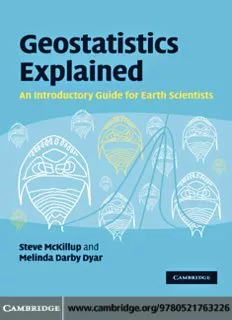
Geostatistics Explained: An Introductory Guide for Earth Scientists PDF
Preview Geostatistics Explained: An Introductory Guide for Earth Scientists
This page intentionally left blank Geostatistics Explained AnIntroductoryGuideforEarthScientists This reader-friendly introduction to geostatistics provides a lifeline for studentsandresearchersacrosstheEarthandenvironmentalscienceswho until now have struggled with statistics. Using simple and clear explan- ationsforbothintroductoryandadvancedmaterial,itdemystifiescom- plexconceptsandmakesformulasandstatisticaltestseasytounderstand andapply. Thebookbeginswithadiscussionandcriticalevaluationofexperimental and sampling design before moving on to explain essential concepts of probability,statisticalsignificanceandType1andType2error.Testsforone andtwosamplesarepresented,followedbyanaccessiblegraphicalexplan- ationofanalysisofvariance(ANOVA).MoreadvancedANOVAdesigns, correlationandregression,andnon-parametrictestsincludingchi-square, are then considered. Finally, it introduces the essentials of multivariate techniques such as principal components analysis, multidimensional scalingandclusteranalysis,analysisofsequences(especiallyautocorrelation andsimpleregressionmodels)andconceptsofspatialanalysis,including thesemivariogramanditsapplicationinKriging. Illustrated with wide-ranging and interesting examples from topics across the Earth and environmental sciences, Geostatistics Explained provides a solidgrounding in the basic methods, as well as serving as a bridgetomorespecializedandadvancedanalyticaltechniques.Itcanbe usedforanundergraduatecourseorforself-studyandreference.Worked examplesattheendofeachchapterhelpreinforceaclearunderstanding ofthestatisticaltestsandtheirapplications. Steve McKillup is an Associate Professor in the Department of Biosystems and Resources at Central Queensland University. He has received several tertiaryteaching awards,including the Vice-Chancellor’s AwardforQualityTeachinganda2008AustralianLearningandTeaching Council citation “For developing a highly successful method of teaching complexphysiologicalandstatisticalconcepts,andembodyingthatmethod in an innovative international textbook.” He is the author of Statistics Explained: An Introductory Guide for Life Scientists (Cambridge, 2006). Hisresearchinterestsincludebiologicalcontrolofintroducedspecies,the ecologyofsoft-sedimentshoresandmangroveswamps. Melinda Darby Dyar is an Associate Professor of Geology and Astronomy at Mount Holyoke College, Massachusetts. Her research interests range from innovative pedagogies and curricular materials to thecharacterizationofplanetarymaterials.Shehasstudiedsamplesfrom mid-oceanridgesandeverycontinentonEarth,aswellasfromthelunar highlands and Mars. She is a Fellow of the Mineralogical Society of America,andtheauthororcoauthorofmorethan130refereedjournal articles.SheistheauthoroftwomineralogyDVDsusedincollege-level teaching,andatextbook,MineralogyandOpticalMineralogy(2008). Geostatistics Explained An Introductory Guide for Earth Scientists STEVE McKILLUP CentralQueenslandUniversity MELINDA DARBY DYAR MountHolyokeCollege,Massachusetts CAMBRIDGE UNIVERSITY PRESS Cambridge, New York, Melbourne, Madrid, Cape Town, Singapore, São Paulo, Delhi, Dubai, Tokyo Cambridge University Press The Edinburgh Building, Cambridge CB2 8RU, UK Published in the United States of America by Cambridge University Press, New York www.cambridge.org Information on this title: www.cambridge.org/9780521763226 © Steve McKillup and Melinda Darby Dyar 2010 This publication is in copyright. Subject to statutory exception and to the provision of relevant collective licensing agreements, no reproduction of any part may take place without the written permission of Cambridge University Press. First published in print format 2010 ISBN-13 978-0-511-67730-4 eBook (NetLibrary) ISBN-13 978-0-521-76322-6 Hardback ISBN-13 978-0-521-74656-4 Paperback Cambridge University Press has no responsibility for the persistence or accuracy of urls for external or third-party internet websites referred to in this publication, and does not guarantee that any content on such websites is, or will remain, accurate or appropriate. Contents Preface page xv 1 Introduction 1 1.1 Whydoearthscientistsneedtounderstandexperimental designandstatistics? 1 1.2 Whatisthisbookdesignedtodo? 6 2 “Doingscience”:hypotheses,experimentsanddisproof 8 2.1 Introduction 8 2.2 Basicscientificmethod 8 2.3 Makingadecisionaboutahypothesis 11 2.4 Whycan’tahypothesisortheoryeverbeproven? 11 2.5 “Negative”outcomes 12 2.6 Nullandalternatehypotheses 12 2.7 Conclusion 13 2.8 Questions 14 3 Collectinganddisplayingdata 15 3.1 Introduction 15 3.2 Variables,samplingunitsandtypesofdata 15 3.3 Displayingdata 17 3.4 Displayingordinalornominalscaledata 21 3.5 Bivariatedata 21 3.6 Dataexpressedasproportionsofatotal 25 3.7 Displayofgeographicdirectionororientation 26 3.8 Multivariatedata 26 3.9 Conclusion 27 v vi Contents 4 Introductoryconceptsofexperimentaldesign 28 4.1 Introduction 28 4.2 Sampling:mensurativeexperiments 29 4.3 Manipulativeexperiments 34 4.4 Sometimesyoucanonlydoanunreplicatedexperiment 40 4.5 Realism 41 4.6 Abitofcommonsense 42 4.7 Designinga“good”experiment 43 4.8 Conclusion 44 4.9 Questions 44 5 Doingscienceresponsiblyandethically 45 5.1 Introduction 45 5.2 Dealingfairlywithotherpeople’swork 45 5.3 Doingthesamplingortheexperiment 47 5.4 Evaluatingandreportingresults 48 5.5 Qualitycontrolinscience 50 5.6 Questions 50 6 Probabilityhelpsyoumakeadecisionabout yourresults 51 6.1 Introduction 51 6.2 Statisticaltestsandsignificancelevels 52 6.3 Whathasthisgottodowithmakingadecisionor statisticaltesting? 57 6.4 Makingthewrongdecision 57 6.5 Otherprobabilitylevels 58 6.6 Howareprobabilityvaluesreported? 60 6.7 Allstatisticaltestsdothesamebasicthing 60 6.8 Averysimpleexample:thechi-squaretestforgoodnessoffit 60 6.9 Whatifyougetastatisticwithaprobabilityofexactly0.05? 64 6.10 Conclusion 65 6.11 Questions 65 7 Workingfromsamples:data,populationsandstatistics 66 7.1 Usingasampletoinferthecharacteristicsofapopulation 66 7.2 Statisticaltests 66 Contents vii 7.3 Thenormaldistribution 66 7.4 Samplesandpopulations 71 7.5 Yoursamplemeanmaynotbeanaccurateestimateofthe populationmean 73 7.6 Whatdoyoudowhenyouonlyhavedatafromone sample? 75 7.7 Whyarethestatisticsthatdescribethenormal distributionsoimportant? 78 7.8 Distributionsthatarenotnormal 80 7.9 Otherdistributions 80 7.10 Otherstatisticsthatdescribeadistribution 82 7.11 Conclusion 83 7.12 Questions 84 8 Normaldistributions:testsforcomparingthemeans ofoneandtwosamples 85 8.1 Introduction 85 8.2 The95%confidenceintervaland95%confidencelimits 85 8.3 Using the Z statistic to compare a sample mean and population mean when population statistics are known 86 8.4 Comparingasamplemeantoanexpectedvaluewhen populationstatisticsarenotknown 87 8.5 Comparingthemeansoftworelatedsamples 96 8.6 Comparingthemeansoftwoindependentsamples 98 8.7 Areyourdataappropriateforattest? 100 8.8 Distinguishingbetweendatathatshouldbeanalyzedby apaired-sampletestandatestfortwoindependent samples 102 8.9 Conclusion 103 8.10 Questions 103 9 Type1andType2error,powerandsamplesize 105 9.1 Introduction 105 9.2 Type1error 105 9.3 Type2error 106 9.4 Thepowerofatest 109 viii Contents 9.5 WhatsamplesizedoyouneedtoensuretheriskofType2 errorisnottoohigh? 111 9.6 Type1error,Type2errorandtheconceptofrisk 113 9.7 Conclusion 113 9.8 Questions 114 10 Single-factoranalysisofvariance 115 10.1 Introduction 115 10.2 Single-factoranalysisofvariance 116 10.3 Anarithmetic/pictorialexample 122 10.4 Unequalsamplesizes(unbalanceddesigns) 128 10.5 AnANOVAdoesnottellyouwhichparticulartreatments appeartobefromdifferentpopulations 128 10.6 Fixedorrandomeffects 128 10.7 Questions 129 11 MultiplecomparisonsafterANOVA 131 11.1 Introduction 131 11.2 MultiplecomparisontestsafteraModelIANOVA 131 11.3 AnaposterioriTukeycomparisonfollowingasignificant resultforasingle-factorModelIANOVA 134 11.4 Otheraposteriorimultiplecomparisontests 138 11.5 Plannedcomparisons 138 11.6 Questions 140 12 Two-factoranalysisofvariance 142 12.1 Introduction 142 12.2 Whatdoesatwo-factorANOVAdo? 145 12.3 Howdoesatwo-factorANOVAanalyzethesedata? 146 12.4 Howdoesatwo-factorANOVAseparateouttheeffectsof eachfactorandinteraction? 150 12.5 Anexampleofatwo-factoranalysisofvariance 153 12.6 Someessentialcautionsandimportantcomplications 154 12.7 Unbalanceddesigns 164 12.8 Morecomplexdesigns 164 12.9 Questions 165
Description: